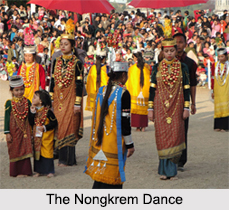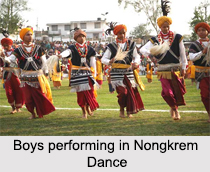 Nongkrem Dance is chiefly performed by the "Khasi tribe" with the background of the delectable destination of the mountains. As autumn drops by the hills, this magnanimous occasion witnesses its advent, its verve. The mountain comes to life, so do the tribe as the mood of tribal festivity pours in.
Nongkrem Dance is chiefly performed by the "Khasi tribe" with the background of the delectable destination of the mountains. As autumn drops by the hills, this magnanimous occasion witnesses its advent, its verve. The mountain comes to life, so do the tribe as the mood of tribal festivity pours in.
On the fourth day of the "Khasi" dance, all the young girls together perform this dance in a ring in front of the priestess`s house. The dance depicts warlike movements of the young folks who dance in a circle forming a ring in which the girls sway their heads slowly. This dance is considered as one the greatest dance festivals of the "Khasis". "Shad Nongkrem" is the most significant festival of the "Khasis" and the ceremony is performed by the "Syiem of Khyrem" who sacrifices a cock to calm down the gods of the ruling clan and the god of Shillong peak (U-Lei Shillong). The festival is also called "Ka Pomblang". The principle of Nongkrem Dance is to get blessings of Goddess "Ka Blei Synshar" for a vast agricultural yield and happiness of the people.
Origin of Nongkrem Dance
"Nongkrem" is a hilly spot, almost seven miles away from Shillong where the royal family of the "Khasis" inhabit. The name of this place has been derived from the similar source from which the royal family has assumed the name of their clan. Nongkrem Dance is performed at a place named as "Smit" in Nongkrem which has been the seat of the Nongkrem Chief. Earlier the dance was performed at Shillong but when the British occupied the place as their summer resort; the Nongkrem clan had to shift from there.
Time for the celebration of Nongkram Dance
The Nongkram Dance is commemorated in the month of May and often in November. This is because of the shifting of lunar position which decides the time for the next Nongkram Carnival.
Rituals of Nongkrem Dance
 The "Syiem of Khyrim" with the high priest presents the "Pomblang" ritual. He suggests oblation to a "Lei Shillong"; the god of Shillong peak by sacrificing a cock. A significant part of this festival is "Pomblang" (sacrifice of goats). Then offerings are made to the predecessor and ancestress of the ruling clan to the first uncle to the deity of Shillong peak.
The "Syiem of Khyrim" with the high priest presents the "Pomblang" ritual. He suggests oblation to a "Lei Shillong"; the god of Shillong peak by sacrificing a cock. A significant part of this festival is "Pomblang" (sacrifice of goats). Then offerings are made to the predecessor and ancestress of the ruling clan to the first uncle to the deity of Shillong peak.
Dress of Nongkrem Dance
During the dance all the boys and girls wear the best attires. They wear different types of dresses and even they are hugely ornamented. Female dancers wear rich silk cloth and velvet jackets. They also wear ornaments like earrings, necklaces and gold chains. The boys on the other hand wear a sleeveless coat of velvet and also wear a dhoti.
Music of Nongkrem Dance
Around seventy types of tunes are played during the Puja ceremony. The tune is played during the time of dancing is known as "Sing Masteih". The members playing the orchestra are known as `Dhulias` (drummers). Big drums like "Nakra" or "Bom" are played during the time of dancing but not at the time of the Puja. Usually one big drum is played and two musicians play the "Tangmouri" i.e. flute. The sound of a "tangmouri" resembles a bagpipe. Other instruments like the "Padia" or a pair of cymbals is also played and a kind of tom-tom known as "Ksing" is used as well. The "Ksing" is prepared of soil and is struck with the help of sticks. The orchestra group is made to sit in one corner of the dancing area on a raised platform. The audience either sits or stands on a given open space around the field.
Celebrations and Festivals associated with Nongkram Dance
In Khasi Hills the Nongkrem Dance Carnival is also recognized as Shad Nongkrem and is performed each year at "Smit", the capital of "Khyrem Syiemship" next to Shillong. There is an essential event that is integrally linked to this festival; it is the execution of goats. During the month of the `Bazar days`; the date of the commencement of the Puja is fixed. The ruling chief is then informed who later informs the others of the date of the festival. On the third day of the puja which is celebrated as the sacrificial day, the principal goat is sacrificed by the ruling Chief. Around 50 to 60 "Dhulias" (drummers) play their instrument throughout the day and night in turns during the Puja. They play their drums in all the 27 tunes. On the fourth day of the festival the Nongkrem dance is performed from early morning till late in the evening to appease the God. Sacrifices are presented to the forefathers and foremothers of the ruling class, to the controlling God of Shillong Peak and also to the 1st Uncle. The sacrifice of animal at the Altar is a part of the ritual that is recognized as "Pomblang" amongst the people of Khasi Hills. The celebration is accompanied by dances of young boys and girls. It is a sort of giving respect to religion.
Early in the morning the princess of the clan visit the temple with few unmarried girls of the royal family. Once the puja is over all the Khasi girls of the state along with the princess perform the dance in an open area before the temple. The princess dancing with the common mass signifies the picture of the fellow feeling, the democracy, the equality of social class ; the aristocratic hierarchy with the cross sectioned marginalised communities. Richly dressed and heavily ornamented girls with their hands hanging down on both the sides slowly sway forward and backward. At times, they are encircled by male dancers who dance in a circle projecting their martial type of dancing. The dancers make two groups by forming two semi-circles and advance forward and retreat back when half of the circle is complete. When the men face each other they make a right about turn and then finish the semi-circle.
Their dance movements depict the warriors adopting their defensive attitude. The underlying idea conveyed from their dance pattern is that the tribe is always prepared to protect their womenfolk, property and jewels from the outsiders. During the dance the girls wear their best attire and as a general rule they need to be unmarried. There is no restriction for the male members as they can be both unmarried as well as married.




